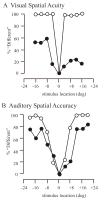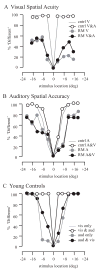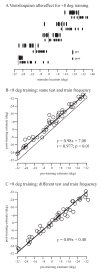Interactions of auditory and visual stimuli in space and time
- PMID: 19393306
- PMCID: PMC2787663
- DOI: 10.1016/j.heares.2009.04.009
Interactions of auditory and visual stimuli in space and time
Abstract
The nervous system has evolved to transduce different types of environmental energy independently, for example light energy is transduced by the retina whereas sound energy is transduced by the cochlea. However, the neural processing of this energy is necessarily combined, resulting in a unified percept of a real-world object or event. These percepts can be modified in the laboratory, resulting in illusions that can be used to probe how multisensory integration occurs. This paper reviews studies that have utilized such illusory percepts in order to better understand the integration of auditory and visual signals in primates. Results from human psychophysical experiments where visual stimuli alter the perception of acoustic space (the ventriloquism effect) are discussed, as are experiments probing the underlying cortical mechanisms of this integration. Similar psychophysical experiments where auditory stimuli alter the perception of visual temporal processing are also described.
Figures










Similar articles
-
Auditory dominance over vision in the perception of interval duration.Exp Brain Res. 2009 Sep;198(1):49-57. doi: 10.1007/s00221-009-1933-z. Epub 2009 Jul 14. Exp Brain Res. 2009. PMID: 19597804
-
Cross-modal perceptual integration of spatially and temporally disparate auditory and visual stimuli.Brain Res Cogn Brain Res. 2003 May;16(3):468-78. doi: 10.1016/s0926-6410(03)00074-0. Brain Res Cogn Brain Res. 2003. PMID: 12706226 Clinical Trial.
-
A neurocomputational analysis of the sound-induced flash illusion.Neuroimage. 2014 May 15;92:248-66. doi: 10.1016/j.neuroimage.2014.02.001. Epub 2014 Feb 9. Neuroimage. 2014. PMID: 24518261
-
The biological basis of audition.Annu Rev Psychol. 2008;59:119-42. doi: 10.1146/annurev.psych.59.103006.093544. Annu Rev Psychol. 2008. PMID: 17678445 Free PMC article. Review.
-
Intersensory binding across space and time: a tutorial review.Atten Percept Psychophys. 2013 Jul;75(5):790-811. doi: 10.3758/s13414-013-0475-4. Atten Percept Psychophys. 2013. PMID: 23709064 Review.
Cited by
-
Reality and illusion: the assessment of angular separation of multi-modal signallers in a duetting bird.Proc Biol Sci. 2022 Jul 13;289(1978):20220680. doi: 10.1098/rspb.2022.0680. Epub 2022 Jul 13. Proc Biol Sci. 2022. PMID: 35858056 Free PMC article.
-
Relearning auditory spectral cues for locations inside and outside the visual field.J Assoc Res Otolaryngol. 2014 Apr;15(2):249-63. doi: 10.1007/s10162-013-0429-5. Epub 2013 Dec 4. J Assoc Res Otolaryngol. 2014. PMID: 24306277 Free PMC article.
-
Visual Influences on Auditory Behavioral, Neural, and Perceptual Processes: A Review.J Assoc Res Otolaryngol. 2021 Jul;22(4):365-386. doi: 10.1007/s10162-021-00789-0. Epub 2021 May 20. J Assoc Res Otolaryngol. 2021. PMID: 34014416 Free PMC article. Review.
-
Interrelations Between Temporal and Spatial Cognition: The Role of Modality-Specific Processing.Front Psychol. 2018 Dec 21;9:2609. doi: 10.3389/fpsyg.2018.02609. eCollection 2018. Front Psychol. 2018. PMID: 30622495 Free PMC article. Review.
-
Interaction of perceptual grouping and crossmodal temporal capture in tactile apparent-motion.PLoS One. 2011 Feb 23;6(2):e17130. doi: 10.1371/journal.pone.0017130. PLoS One. 2011. PMID: 21383834 Free PMC article. Clinical Trial.
References
-
- Abel SM, Giguere C, Consoli A, Papsin BC. The effect of aging on horizontal plane sound localization. J Acoust Soc Amer. 2000;108:743–752. - PubMed
-
- Alais D, Burr D. The ventriloquist effect results from near-optimal bimodal integration. Curr Biol. 2004;14:257–262. - PubMed
-
- Altshuler MW, Comalli PE. Effect of stimulus intensity and frequency on median horizontal plane sound localization. J Auditory Res. 1975;15:262–265.
-
- Barraclough NE, Xiao D, Baker CI, Oram MW, Perrett DI. Integration of visual and auditory information by superior temporal sulcus neurons responsive to the sight of actions. J Cog Neurosci. 2005;17:377–391. - PubMed
-
- Beauchamp MS. See me, hear me, touch me: multisensory integration in lateral occipital-temporal cortex. Curr Opin Neurobiol. 2005;15:145–153. - PubMed
Publication types
MeSH terms
Grants and funding
LinkOut - more resources
Full Text Sources
Other Literature Sources

